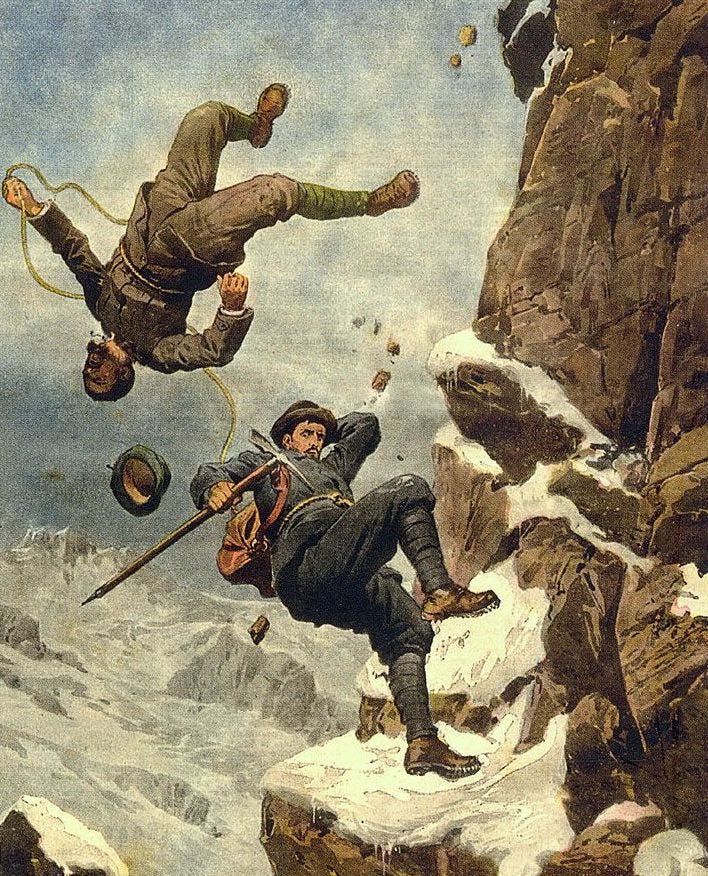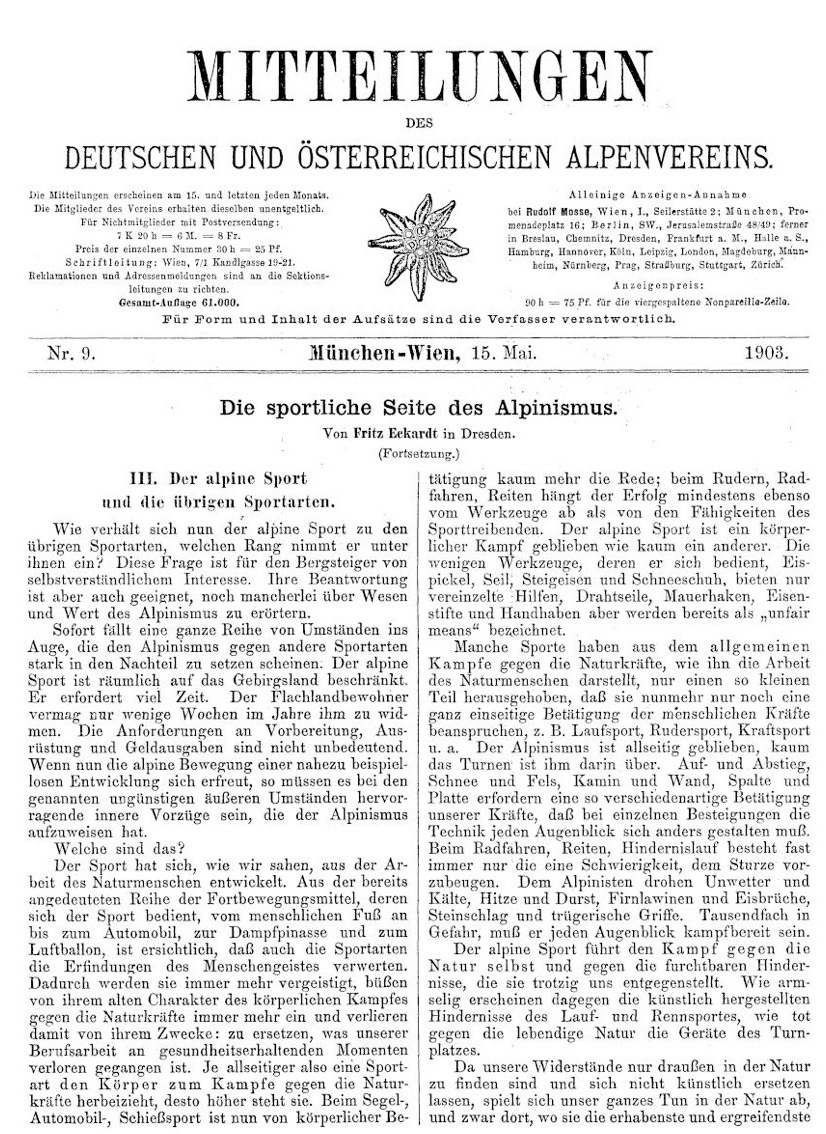Climbing Pitons Early Evolution--part 1b--Alpine ways and artificial aids.
Mechanical Advantage #8b
Buy the books here:
Volume 1: (mostly) European Tools and Techniques to the 1930s
Volume 2: (mostly) North American Climbing Tools and Techniques to the 1950s
(Climbing Pitons Early Evolution, part 1a is here)
Alpine Ways—the context of early pitons
In the years before World War I, technical climbing started to branch off from other forms of alpine mountaineering, which had become mainstream in the early 1900’s. The German-Austrian Alpenverein (merged in 1873) exploded in membership from less than 5000 members in 1874 to over 100,000 by the 1910’s (ZDÖAV, 1919). Club Alpin Français, Schweizer Alpen-Club, Club Alpino Italiano also boomed. Comfortable huts that could sleep 50 or more were constructed in the high meadows (and even on cliffs) where there was once only a small shepherd’s shack. New railroads allowed easy pan-European travels, and tunnels bored through the Alps like the Mont Cenis Tunnel (completed in 1871) allowed passage between mountain ranges that would have been a major expedition for the previous generation. No longer would legends of Hannibal’s crossing of the Alps prevail when planning a trip from the lowlands —the mountain dragons were being tamed both above ground and underground.

Perhaps the “Alpine Way” is best exemplified as the progress on the Zugspitze (2692m) in the Wetterstein range in the Eastern Alps. First climbed in 1820 as a celebrated alpine climbing achievement, subsequents ascents were relatively few until an alpenweg began in 1875. A 15m slab was equipped with an iron ladder (the 1911 guide calls it the “chicken ladder”) and a series of drilled iron rods (“Eisenstiften”) with wire cables protected a slippery traverse. In 1897 a large refuge—the Münchner Haus—was built on its summit. The accessibility of Germany’s highest mountain caused a rift in the alpine clubs as thousands of high tourists (“Hochtouristen”) swarmed the summit, with many climber/mountaineers lamenting how the Queen of the Bavarian Alps had “lost its horror”.
Footnote: these paths now differentiated from climbing routes as via ferrata (Italian) and Klettersteig (German). See also Purtscheller, “On the history of the development of the Alpinism and alpine technology in the German and Austrian Alps” (1894 ZDOAV). Of note is E. Strutt’s report on his adventures in the Eastern Alps in the 1890’s, referring to the route, “Even now, when the cliffs have been engineered beyond all reason, the climb from the Höllental still counts as a good expedition.” (1942 Alpine journal). Similar routes up many iconic alpine peaks such as Triglav also were constructed in this era. The first cable car to the summit of the Zugspitze was built in 1926, with technology adopted from the mining industry.

Insurances and Artificial Aids
Installing metal bolts and wire cables to protect exposed areas and provide steps and handholds in the mountains was referred to as the ‘fixing of insurances’ (“Anbringung von Versicherungen”). “Künstliche Hilfsmittel” (artificial aid) first appears in the 1880’s German-Austrian Alpine journals, which included wood ladders, ropes tossed over flakes, and even rockets fired over summits, in addition to the iron rods and cables being installed on alpine paths. Failure on a climb was often excused by suggesting the route was “absolutely inaccessible without the use of artificial aids” (1891). The debate of what constituted aid in the mountains was fuelled as more portable “insurances” were developed with modern technology, and continued in the following decades (footnote).
Footnote: Discussions of what constituted “Artificial aid” reached a crescendo with the famous piton debates between Preuss, Piaz, Nieberl, Jacobi and Dülfer in the 1911/1912 Mitteilungen des Deutschen und Österreichischen Alpenvereins. Later in the 1920’s, bottled oxygen and oxygen masks on high mountains is included in the long running debate of Künstlichen Hilfsmittel.


Changing attitudes to Mauerhaken
Starting in 1885, the term “Mauerhaken” (wall hook) appears in the German-Austrian Alpine Journal first as rappel anchor, then as a belay anchor, and eventually as an aid for ascent on many routes. In 1894, Purtscheller reports on the first traverse of the Meije with the Zsigmondy brothers, “One of the most terrible abseiling points is located on the Zsigmondy ridge between Pic Central and Grand Pic de la Meije, its height is thought to be around 30 m. The foot of the rock face, because it overhangs, is hidden from view. (We) overcame this point by driving a Mauerhaken into a crevice in the rock slab, wedging it firmly with stones and attaching a Seilring. Such tricks with the rope are always a bit daring; they can only be justified in those cases where there are no other means.”
But by the end of the 1800’s, three Mauerhaken were standard equipment for many German and Austrian alpinists, and fixed pitons were noted at crux sections in route descriptions. By the early 1900’s, climbers in the Eastern Alps began to openly admit the use of Mauerhaken for ascent. During an ascent of the Watzmann (Germany’s 3rd highest peak), von Frerichs admits driving a wall hook to overcome an overhang: “the rock became climbable, the terrible wall lay below us,” but then adds, “maybe this confession costs me my mountaineering reputation.”
In 1903, Fritz Eckardt from Dresden philosophised in a series on “Sporting side of Alpinism”, comparing climbing to other athletic pursuits and how many sports depend on the tools as much as the capabilities of the sportsperson (he also presciently discusses concerns of future competition). Eckardt references how aids like wire ropes, pitons, bolts, and handrails are called “unfair means” (which he writes in English presumably as a counterpoint to British ethics), yet also includes ice axe, rope, crampons and snowshoes as tools for isolated aid in the alpinist’s toolkit. In the struggle of ascent, Eckhardt emphasises how only nature dictates the necessary equipment, the “inventions of the human spirit”.
So how did these mechanical advantage devices become more portable? Piton evolution, part 1c to come!

Next: part 1c
LINKS
In the Beginning: Subtle Means and Engines
The Modern Era of Mountaineering (1786)
American Trail Builders, 1800's
Rope Technology in the 19th century
Mizzi Langer -- first advertised rock climbing pitons (Mauerhaken)
Climbing Pitons Early Evolution--part 1a
Climbing Pitons Early Evolution--part 1b
Climbing Pitons Early Evolution--part 1c
Climbing Pitons Early Evolution--part 1d
Climbing Pitons Early Evolution-part 1e
Tita Piaz-Alpinisto Acrobatico (Piaz PartA)







